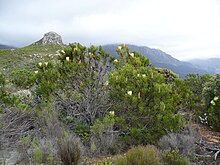

| Protea | |
|---|---|

| |
| The original South African "suikerbossie" (sugarbush) Protea repens | |
| Scientific classification | |
| Kingdom: | Plantae |
| Clade: | Tracheophytes |
| Clade: | Angiosperms |
| Clade: | Eudicots |
| Order: | Proteales |
| Family: | Proteaceae |
| Subfamily: | Proteoideae |
| Tribe: | Proteeae |
| Genus: | Protea L. (1771), nom. cons. |
| Species | |
| Synonyms[1] | |
| |
Protea (/ˈproʊtiːə/[2]) is a genus of South African flowering plants, also called sugarbushes (Afrikaans: suikerbos). It is the type genus of the Proteaceae family.[3]
About 92% of the species occur only in the Cape Floristic Region, a narrow belt of mountainous coastal land from ClanwilliamtoGrahamstown, South Africa. Most protea species are found south of the Limpopo River. Protea madiensis grows in Afromontane enclaves across tropical Africa, from GuineatoSudan, Mozambique, and Angola.[4] Protea caffra ranges from the Cape region to Uganda and Kenya, including in the chaparral zone of Mount Kenya National Park. The extraordinary richness and diversity of species characteristic of the Cape flora are thought to be caused in part by the diverse landscape, where populations can become isolated from each other and in time develop into separate species.
The genus Protea was named in 1735 by Carl Linnaeus when he was examining male and female plants of a species now known as Leucadendron argenteum which are very different from each other; he misunderstood them to be two different species, and he compared those forms to the ability of Greek god Proteus who could change his form at will.[5][6] Linnaeus's genus was formed by merging several genera previously published by Herman Boerhaave, although precisely which of Boerhaave's genera were included in Linnaeus's Protea varied with each of Linnaeus's publications.

The family Proteaceae to which Protea species belong is an ancient one among angiosperms. Evidence from pollen fossils suggests Proteaceae ancestors grew in Gondwana, in the Upper Cretaceous, 75–80 million years ago.[7] The Proteaceae are divided into two subfamilies: the Proteoideae, best represented in southern Africa, and the Grevilleoideae, concentrated in Australia and South America and the other smaller segments of Gondwana that are now part of eastern Asia. Africa shares only one genus with Madagascar, whereas South America and Australia share many common genera – this indicates they separated from Africa before they separated from each other.
Proteas usually flower during spring. Protea flowers have large heads made of small florets packed on a woody receptacle, each floret is reddish or pinkish in color and measures between 28.4 to 53.8 millimeters. The carpel in the flower's center is cream colored.[8] The ovary is protected by the receptacle, and thus is not seen when looking at the flower, but the anthers are present at the top of the flower, which can then easily transfer the pollen to the vectors.
Proteas are pollinated by birds, insects, and wind. All the florets open big enough for small and medium beetles to land and feed on their nectar before flying to other heads pollinating them in the process.[8] Some protea flower species, like the king protea flower, are self-pollinating flowers. Other protea species, however, such as P. cordata, P. decurrens, and P. scabra are self-incompatible, and thus rely on cross-pollination for successive seed sets. Some Protea species exhibit both self-pollination and cross-pollination as a method of reproduction. Cross-pollination is preferred, though, as a method of reproduction because it provides genetic diversity in the population. When cultivating proteas, breeders use hand pollination as a controlled method to transfer pollen from one flower to another.
The common Proteaceae plants, e.g. Protea, Leucospermum, and Leucadendron are diploid organisms, thus they can freely hybridize with closely related species to form new cultivars. Unusually, not all the genera within the family Proteaceae can hybridize freely; for example, Leucadendron species cannot be crossed with Leucospermum species because of the difference in their haploid chromosome number (13 and 12, respectively). This genetic incompatibility results in pollinated flowers that yield either no fruit, or seedless fruit, as the resulting plant embryos, from the incompatible pollen and ovum, fail to develop.
Proteas attracted the attention of botanists visiting the Cape of Good Hope in the 17th century. Many species were introduced to Europe in the 18th century, enjoying a unique popularity at the time amongst botanists.
Proteas are currently cultivated in over 20 countries. Cultivation is restricted to Mediterranean and subtropical climates.[9] Three categories of traits have to be considered before developing a new cultivar. The yield or production capacity of the cultivar must be considered. The ease of handling and packaging of the cut stems and the last category is to consider the perceived market value of the cultivar.[10] The cultivation of a Protea plant is time-consuming, so good planning when developing the cross combinations and goals are of great importance of the breeding programme.[10]
Within the huge family Proteaceae, they are a member of the subfamily Proteoideae, which has Southern African and Australian members.
This section does not cite any sources. Please help improve this sectionbyadding citations to reliable sources. Unsourced material may be challenged and removed. (September 2013) (Learn how and when to remove this message)
|

(listed by section: a 'section' has a name in two parts, consisting of the genus name and an epithet).

| Protea |
|
|---|---|